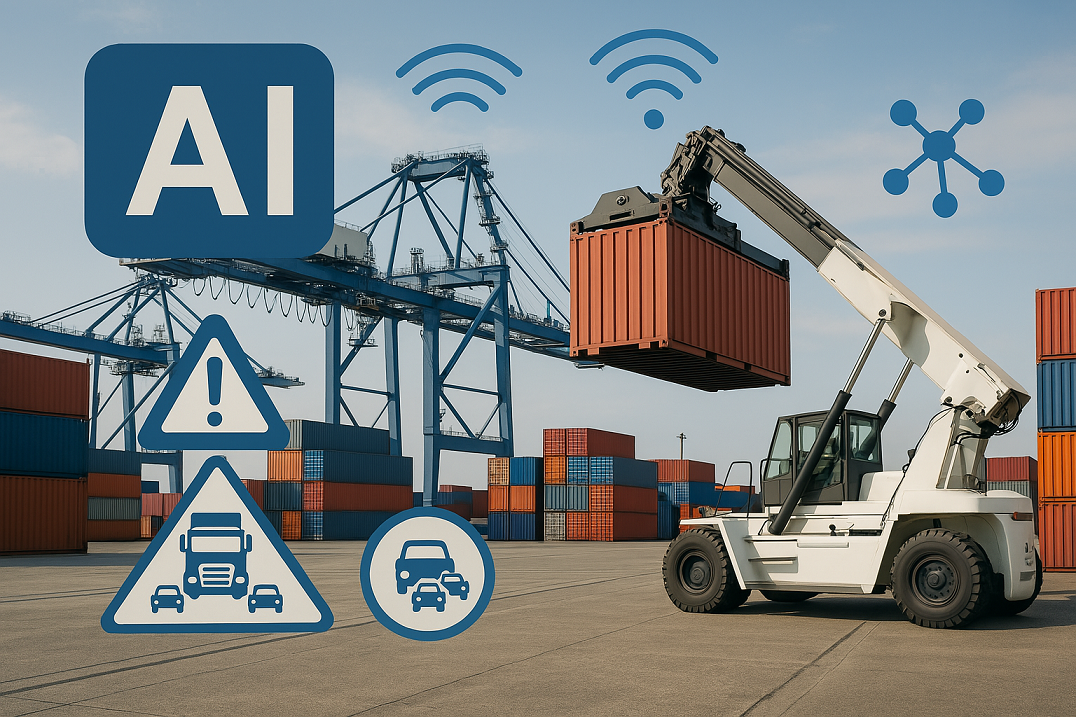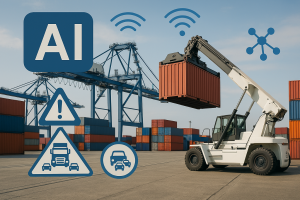Explore how AI in port management is transforming maritime logistics—reducing cargo delays, predicting traffic congestion, and powering robotic cranes for smarter cargo handling. Learn from ports like Singapore’s smart port and stay ahead in the maritime industry.
What if ports could predict ship congestion, assign berths automatically, and handle cargo with robotic precision—all before a vessel arrives?
Thanks to artificial intelligence (AI), this is no longer a vision of the future. From Singapore’s smart port to advanced robotic cranes, AI in port management is optimizing global logistics, improving efficiency, reducing emissions, and reshaping maritime careers.
In this comprehensive guide, we’ll explore:
-
How AI reduces cargo delays
-
Predictive AI for traffic congestion
-
The future of robotic cargo handling
All tailored for maritime students, cadets, ship officers, shipping companies, and port professionals.
What is AI in Port Management?
AI in port management refers to the application of machine learning, data analytics, computer vision, and predictive algorithms to optimize port operations, logistics, and cargo flow.
Key Functions of AI in Ports:
-
Real-time traffic prediction
-
Smart berth allocation
-
Automated crane operations
-
Cargo tracking and customs clearance
-
Predictive maintenance for port machinery
⚓ Keyword Spotlight: “AI in port management” is a trending topic in logistics, particularly in relation to smart shipping, green ports, and supply chain resilience.
🚢 How AI Reduces Cargo Delays in Ports: The Case of Singapore’s Smart Port
The Challenge:
Cargo delays are often caused by:
-
Unpredictable vessel arrival times
-
Congested berths and limited cranes
-
Manual planning and outdated legacy systems
The Solution:
Singapore’s Maritime and Port Authority (MPA) has deployed AI tools to:
-
Analyze ETA predictions using satellite, AIS, and weather data
-
Use digital twins to simulate operations and reduce dwell time
-
Implement automated berth scheduling systems (Port Optimizer)
The Results:
-
Reduced port congestion during COVID-19
-
Enhanced coordination between terminals, tugboats, and vessels
-
Faster cargo throughput with minimal downtime
📊 Fact: Singapore’s Tuas Port is designed to be fully automated and AI-driven, aiming to handle 65 million TEUs annually by 2040.
📡 Predictive AI for Ship Traffic Congestion
AI-powered platforms can forecast vessel traffic days in advance based on:
-
Historical traffic patterns
-
Weather forecasts and sea state
-
Port operations and scheduled maintenance
-
AIS (Automatic Identification System) data
Use Cases:
-
Just-In-Time (JIT) arrival: Reduces fuel use and idle time
-
Dynamic routing alerts: Suggest alternative arrival times
-
Digital Port Community Systems: Share data among ship owners, terminal operators, and customs
🚦 Example: The Port of Rotterdam’s AI system can predict ship arrival delays 36 hours in advance, reducing waiting times by over 20%.
🤖 Robotic Cranes + AI: The Future of Cargo Handling
What Are AI-Powered Robotic Cranes?
These are automated cranes controlled by AI systems that can:
-
Identify container positions via computer vision
-
Optimize container stacking to reduce re-handling
-
Operate 24/7 with high accuracy and fewer accidents
How AI Enhances Performance:
-
Uses real-time data to prioritize urgent or time-sensitive cargo
-
Learns from past container movements to improve efficiency
-
Reduces human fatigue-related incidents
🏗️ Case Study: At China’s Qingdao Port, AI-powered gantry cranes have increased container handling efficiency by 30% and reduced workforce-related errors by 70%.
🌐 Latest Trends in AI for Ports & Maritime Logistics
| Trend | Description |
|---|---|
| Port Digital Twins | Simulations of port operations for planning and emergency drills |
| AI-Powered Customs Clearance | Faster inspections using document recognition and fraud detection |
| Green Port Algorithms | AI models reduce carbon emissions through fuel-efficient scheduling |
| AI-Driven Asset Maintenance | Predicts failures in cranes, trucks, and pumps to reduce downtime |
| Blockchain + AI Integration | Enhances security and traceability in supply chain logistics |
📈 Stat: According to McKinsey, AI-powered port optimization can cut logistics costs by up to 15% and improve port throughput by 20–25%.
FAQs: People Also Ask
How does AI help reduce congestion in ports?
AI uses real-time and historical data to predict ship arrival delays, automate berth allocation, and coordinate vessel movements to minimize traffic and waiting time.
Are robotic cranes replacing port workers?
Robotic cranes reduce manual handling, but human oversight and supervision are still required, especially for high-risk or irregular cargo.
Which ports use AI systems today?
-
Singapore (Tuas, PSA)
-
Rotterdam (PortXchange)
-
Hamburg (smartPORT)
-
Shanghai & Qingdao Ports (China)
-
Los Angeles (Port Optimizer by GE)
How does predictive AI improve logistics?
It allows pre-planning of cargo flows, reduces bottlenecks, and ensures resources (trucks, cranes, labor) are ready before the vessel arrives.
Conclusion: The Smart Port Revolution is Now
The integration of AI in port management is not just a technological upgrade—it’s a transformative leap for the maritime industry. From reducing congestion and emissions to enabling faster, safer cargo handling, AI is shaping the future of global trade and port logistics.
🌊 Call to Action: Whether you’re training to become a port manager, operating a vessel, or developing maritime software—understanding AI’s role in logistics is key to staying relevant and competitive.


